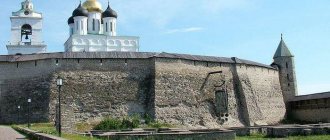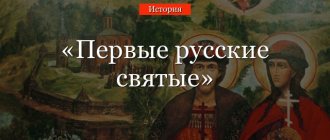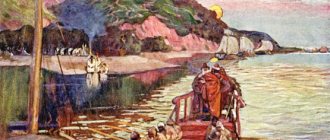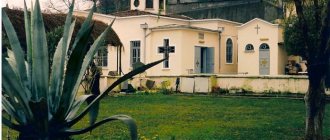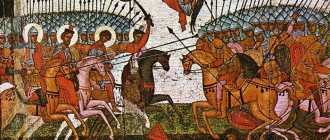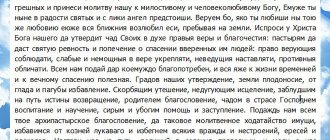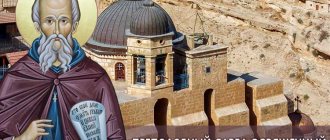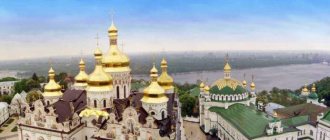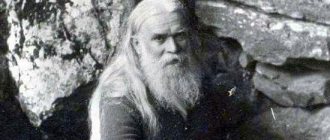The Life of the Holy Blessed Prince Dmitry Donskoy
The birth in the capital of 1350 was predetermined from above. At the age of nine, having lost his father, he receives the spiritual support of Metropolitan Alexy of Moscow.
God's chosen one was brought up in virtue and purity from infancy, absorbing the atmosphere of Christian morality. Never again will the great ruler deviate from the tenets of Orthodoxy.
Boundless trust in God, strict fasts, prayerful and spiritual deeds were combined with mercy and charity, care for his subordinates and the Russian people.
Description of the iconographic images of the saint and their meaning
One of the most ancient images of the saint is considered to be his image on the hagiographic icon of Metropolitan Alexy from the Assumption Cathedral of the Kremlin, kept today in the Tretyakov Gallery. This is an image from the 80s. XV century letters from the master icon painter Dionysius. The same master in 1503 depicted Demetrius of Donskoy on the hagiographic icon of St. Demetrius of Prilutsky, godfather of one of the sons of the Moscow prince.
The image of Demetrius Donskoy is almost always present in the hagiographies of St. Sergius of Radonezh, a special place in whose biography is occupied by the theme of the Battle of Kulikovo. Scenes of the blessing for the battle, the meeting of the saint's ambassador at the Don River and the visit of the abbot after the battle were included in the hallmarks of the life of the reverend elder already in the 16th-17th centuries, when the Moscow prince had not yet been glorified as a saint. One of these icons with scenes from the Massacre of Mamayev, created in 1680, is kept in the Yaroslavl Art Museum.
In the 19th century Images telling about the appearance of the miraculous icon of St. Nicholas to the prince in the village became widespread. Ugresha.Ancient images from the end of the century before last with this plot can be seen today in the Sergiev Posad Museum-Reserve and in the Moscow Theological Academy.
Sculptural images of the famous commander are also common. For example, the sculpture “The Blessed Prince Dimitry Donskoy”, created by academician of the Imperial Academy of Arts Robert Karlovich Zalemano , placed at the top of the monument to the 1000th anniversary of Russia, erected in 1862 in Veliky Novgorod according to the design of the architect M. O. Mikeshin.
Single images of the holy prince became widespread after his canonization at the end of the 20th century.
Among the most famous icons made by modern authors, the most famous are his face in the sacristy of the Trinity-Sergius Lavra, the icon of A.I. Chashkin in the Church of St. George the Victorious on Poklonnaya Hill, the mosaic image of the prince made by the artist E.N. Klyucharyov for the Moscow Church of the Great Martyr. Demetrius of Thessalonica .
Sometimes authors include the image of Dimitri Donskoy in cathedral compositions of Moscow wonderworkers. An example is the icon “Cathedral of Russian Saints”, painted in 1997 by artist N. E. Aldoshina for the Church of St. Nicholas the Wonderworker in Klenniki.
Who blessed Dmitry Donskoy for the Battle of Kulikovo
Contemporaries honored the noble prince as a fearless and wise commander. Crushing victories over the Horde gave hope of getting rid of the long-term yoke.
But Saint Dmitry Donskoy did not begin a single business without God’s guidance. And therefore, going to the decisive battle of Kulikovo, he takes the blessing of St. Sergius of Radonezh. The elder exhorted them to maintain courage, trust in God, and then the Lord would grant success.
Supported by the support of the saint and his monastic warriors, the prince promises to build a monastery in the name of the Most Holy Theotokos in honor of the victory over the Mongols. At the same time, a miracle happens. The discovery of the incorruptible relics of Alexander Nevsky, the great-grandfather of the holy prince, was reliable evidence of God's help.
In honor of the crushing defeat of the Mongols, the true son of the church was named Donskoy.
Biography
Dmitry I Ivanovich, who received the nickname Dmitry Donskoy for his victory in the Battle of Kulikovo, already at the age of 9 became the Prince of Moscow, and at 13 - the Grand Duke of Vladimir. The reign of Dmitry Donskoy marked the unification of Russian lands with the center in the Moscow principality. Dmitry Ivanovich Donskoy is known as the founder of the white-stone Moscow Kremlin, as a military leader who successfully resisted the Golden Horde, and most importantly, as one of the most just and kind-hearted rulers in Rus'.
Dmitry Donskoy | Newspaper "Culture"
The story of Dmitry Donskoy began in Moscow, in October 1350. He was born into the family of Prince of Moscow Ivan II the Red and his second wife, Princess Alexandra Ivanovna. Dmitry had a sister Anna and a brother Ivan, who received Zvenigorod as citizenship. By the way, the famous Prince Ivan Kalita and Dmitry Donskoy are each other’s grandfather and grandson. A short biography of Dmitry Donskoy managed to count only nine years, when the boy was orphaned. The child accepted the Principality of Moscow, but his guardian, Metropolitan Alexei Fedorovich Byakont, became the de facto ruler. They developed a very warm relationship, and Prince Dmitry Donskoy consulted with Metropolitan Alexy even as an adult.
Prince of Moscow and Grand Duke of Vladimir | Temple in honor of the Dormition of the Blessed Virgin Mary
Before he could sit on the throne, 9-year-old Prince Dmitry I was forced to fight for power in Vladimir with other contenders. Because of the machinations of Prince Mikhail of Tver, a war began between Moscow and Lithuania. Three times the Lithuanian ruler Olgerd tried to seize the principality of young Dmitry, although unsuccessfully, but his attacks greatly undermined the economy: the surrounding area was devastated, thousands of people were taken prisoner. During that period, Moscow was saved from complete ruin by tribute collections.
Why is Dmitry Donskoy canonized?
Until the end of his days he fought for his homeland, and was canonized in 1988 as a defender of the faith and the Fatherland. He laid the foundation for the liberation of the Orthodox land from infidels.
1380, Feast of the Nativity of the Virgin Mary - a great many Orthodox soldiers were killed on the Kulikovo Field. Mourning the fallen warriors, the Grand Duke was even more inspired by the thought of uniting the Fatherland. This is what he strived for, despite the obstacles and dangers, significantly expanding the territory of the Moscow Principality.
The far-sighted and brave ruler entered into an alliance with the Suzdal princess Evdokia, bringing Veliky Novgorod under the auspices of Moscow. In pious union, 12 children were born. His Christian family was a symbol of God-fearing marriage.
He entered the history of the people as an active temple builder. He established Dmitrievskaya Parental Saturday as a tribute to the soldiers who did not return from the field.
Death
The circumstances and cause of death of Dmitry Donskoy have not yet been clarified. It is unlikely that this was a murder, since the prince died in his chambers, having previously had a long conversation with his wife and children. During this conversation-testament, he transferred the reign to his son Vasily, but obliged him to strictly listen to the will of his mother Evdokia Dmitrievna.
Dmitry Donskoy, whose years of life were spent in a tireless struggle against European invaders and the Golden Horde, died on May 19, 1389. At that time he was only 38 years old. The prince was buried in the Archangel Cathedral of the Kremlin, and later the Russian Orthodox Church canonized him.
How does the icon of Dmitry Donskoy help?
The Moscow prince always dreamed of liberating Rus' from the shackles of godlessness and evil. Therefore, on the icon the saint is often represented with a temple in one hand and a sword in the other. Stand up without hesitation to defend the Motherland and the Lord will help. Surrounded by Orthodox churches, it helps resolve state, political and military conflicts.
It is especially soul-saving prayer for politicians, diplomats, and people in high positions. Being a tall man in every sense, Dmitry Donskoy treated his subjects generously and mercifully.
Personal life
Dmitry Donskoy's wife, Evdokia Moskovskaya, is still considered the ideal mother and wife. They met in their youth and, according to legend, fell in love at first sight. At the time of the wedding, the bride was only 13 years old and the groom 16. In any case, the union of Dmitry and Evdokia was very spiritual, as confirmed by church chronicles. Dmitry Donskoy and Evdokia Moskovskaya gave life to 12 children. The most famous of them is the second son Vasily I Dmitrievich, who began to rule after the death of his father, since Dmitry’s firstborn died as a child.
Evdokia Dmitrievna, wife of Dmitry I Ivanovich
Dmitry I and Evdokia spent a lot of effort and money on charity; they built many churches and temples, including the Pereyaslavl monastery, the Church of John the Baptist, the Church of the Nativity of the Virgin Mary and the Ascension Convent in Moscow.
After the death of Dmitry Donskoy, the Orthodox Church canonized | Gorlovka-TV
After the death of her husband, Evdokia of Moscow deviated from tradition and did not immediately take monastic vows, but began to help her son in governing the principality and even occupied the throne when he went to war. Opponents tried to present such a woman’s act as a betrayal of her husband, to accuse her of infidelity and promiscuity, but the people perceived the dowager princess as a wonderful mother who longed for happiness for her children. Evdokia waited until all her sons and daughters had families, and only then took monastic vows, becoming the blessed Euphrosyne, who is now considered the patroness of Moscow.
How to spend the holiday?
Since Dmitry Donskoy remained a significant religious figure in history, on June 1 it is necessary to visit the church in front of his icon to ask for forgiveness for all sins and bad deeds, to ask for strength for new victories that can help in life. You need to turn to the saint only with pure thoughts and a sincere desire to change something in your life, by fighting with yourself or with circumstances.
If there is Dmitry in the family, then you can buy and give the boy such an icon as a talisman given by the Grand Duke.
Orthodox history is rich in wonderful people who sincerely believed in the power of the Lord and tried to glorify him and not themselves through their deeds. Maybe today everyone needs to do at least one significant thing first, which will not benefit themselves, but for the benefit of others. Then the Lord will most likely turn his gaze to the person and will definitely help in difficult times.
Folk traditions
The Slavic peoples singled out Demetrius of Thessaloniki, considering them their patron and protector. Legends and songs have been preserved about how he helped in the war with Mamai.
The Eastern Slavs believed that Demetrius was releasing wolves; from that day on, the danger of predators raiding barns and stables increased. To protect your yard from gray guests, on November 8 it was forbidden to work with livestock or process wool in any way - carding, spinning, weaving, cutting and sewing. On this day, the Southern Slavs performed a ritual of driving out mice and did not open chests to avoid attacks by snakes.
In Slovakia, the saint was considered the patron saint of cattle; shepherds and sheepherders organized holidays in his honor that lasted several days. The Eastern Slavs had a similar custom - they had to brew beer, drink and have fun. In some regions, November 8 was called the “Big Autumn.”
On November 8, the warm half of the year ended, and on this day winter came. They said that the first snow was falling from Dimitri's beard. It was believed that the saint locked the earth with a key; only St. George the Victorious, who came on May 6 (April 25, old style), could unlock it. Therefore, the winter half-year was called “Dmitrievsky”, and the summer half-year - “Yuryevsky”. Serbs, Bosnians and Montenegrins believed that Dimitri and George were twin brothers.
The completion of all matters was timed to coincide with the end of the summer season. So, it was possible to get married only before Dmitri’s Day. The owners had to pay off the workers hired for six months, contracts and debt repayments were expiring. Staying in debt after November 9 is a bad omen; debts will grow next year.
Prayer to the icon
O holy saint of God, righteous Demetrius! By fighting for good on earth, you are the crown of righteousness in heaven that the Lord has prepared for all who love Him. Yet, looking at your holy image, we rejoice at the glorious end of your home and honor your holy memory. But you, standing before the Throne of God, accept our prayers and bring them to the Merciful God, forgive us all our sins and help us to rebel against the tricks of the devil and free ourselves from pain, illness, troubles and misfortunes and everything else. Evil, pious and just we will live in present eternally and we will be glorified by your intercession, if you are unworthy of Esma, see goodness in the land of the living, glorifying the One in your glorified saints God, the Father and the Son and the Holy Spirit now and throughout the ages of ages. Amen.
The history of the holiday
November 8 is associated with the martyrdom of Demetrius, a preacher of Christian teaching. The saint lived in the 3rd-4th centuries AD. e. and was the son of the proconsul of Thessalonica. Demetrius was secretly baptized and raised in the Christian faith. Taking over his father's position by order of the Roman emperor after his death, he began to openly preach and eradicate paganism and idolatry. Under his influence, many city residents converted to Christianity.
The emperor, having learned about this, ordered the proconsul to be imprisoned, and soon the saint was executed. The animals, to which the body was thrown to pieces, did not touch it and local Christians arranged a secret burial. Lupp, Demetrius's slave, took his ring and bloody robe, the objects turned out to be miraculous.
Demetrius was killed on October 26, 306 according to the Julian calendar. With the transition to the new style, the date shifted to November 8th.

